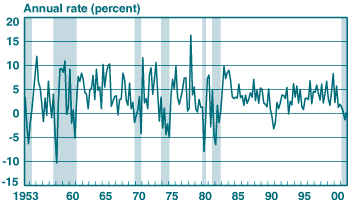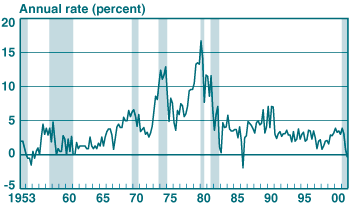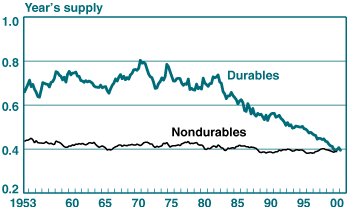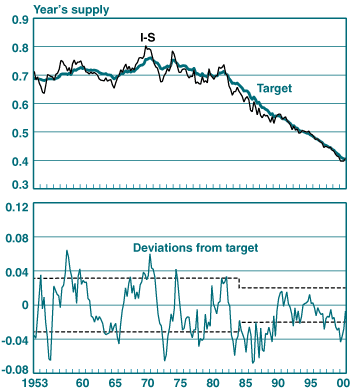| Recapping an article from the May 2002 issue |
|
|
| of the Economic Policy Review, Volume 8, Number 1 | View full article |
|
|
|
20 pages / 224 kb | |
|
Authors: James A. Kahn, Margaret M. McConnell, and |
Disclaimer | |
| Index of executive summaries |
|
Overview The authors investigate why the volatility of both real GDP growth and inflation has declined so strikingly in the United States over the past twenty years. They find that improvements in inventory management—largely the product of technological advances—have played the most important role in stabilizing GDP growth, while more aggressive monetary policy can account for the drop in the volatility of inflation. Countering the widespread view that monetary policy can also explain much of the reduced volatility of GDP growth, the authors conclude that policy's influence on output has been limited. Background Since the early 1980s, output growth and inflation have been only half as volatile as they were in the preceding twenty years (chart). Various explanations for the increased stability of these variables have been put forward. Some studies point to a reduction in the size of the shocks to the economy; other studies emphasize the emergence, in the 1970s, of a monetary policy that has responded more aggressively to economic fluctuations. Kahn, McConnell, and Perez-Quiros consider a third explanation: the "smoothing" of inventory investment as a result of improvements in information technology. Argument and Methodology In the first half of the paper, the authors investigate the sources of the increased stability of U.S. output. To this end, they track the variability in the growth rates of aggregate real GDP and its components—durable goods, nondurable goods, services, and structures—over the 1953-2000 period. Using the standard deviations of the growth rates as their measure of volatility, the authors find that the behavior of durables volatility most closely mimics the behavior of aggregate volatility, with a 50 percent decline in the standard deviation of durables growth after 1984 coinciding with a similar decline in the standard deviation of GDP growth. The authors then establish that the volatility reduction in the durables sector is, in fact, large enough to account for more than two-thirds of the decline in aggregate volatility since 1985. To isolate the factor within durable goods that has helped most to stabilize output, the authors compare the variability of durables production with that of durables final sales. They determine that the reduction in volatility is much greater for production than for final sales—a finding that casts doubt on the notion that more stable demand can account for the increased stability of output. Moreover, because production net of sales is equal to inventory investment, the shift in the relative volatilities of these two variables suggests that a change in inventory management could be behind the increased stability of output. The authors investigate this possibility further by tracking the movements of the inventory-to-sales ratio for the durable goods sector of the U.S. economy. Finding that this ratio began to drop sharply in the early 1980s (chart) and subsequently remained much closer to its target values (chart), the authors conclude that firms have become better at predicting changes in demand. This conclusion is further borne out by regression results indicating that, after 1984, inventory movements anticipated subsequent movements in sales more effectively than they had in the preceding period. The authors go on to argue that firms' improved ability to regulate their inventories very likely owed much to contemporary advances in information technology. Trade publications from the mid-to-late 1980s attest to the dramatic changes taking place in durable goods production technology at that time. In the second half of the paper, the authors construct a model of the U.S. economy to explore the connections between information, monetary policy, and volatility in detail. Suggesting that technological improvements have made it possible to obtain information about final demand much more quickly, the authors assume that firms now get a stronger signal about upcoming changes in demand before they make their production decisions. Simulation of the model shows that improved information about final demand can reduce output volatility, both absolutely and relative to the volatility of sales. Further simulations of the model show that a shift to more aggressive monetary policy has no dramatic effect on output volatility. It does, however, substantially reduce the volatility of inflation. Findings The authors conclude that more effective inventory management explains much of the increased stability of GDP growth. In their view, advances in information technology have enabled firms to anticipate changes in demand, and thus to avoid the extreme swings in inventory that can contribute to output volatility. Better monetary policy, by contrast, does not appear to be an important source of steadier GDP growth. Nevertheless, policy deserves much of the credit for reducing the volatility of inflation in the last two decades. |
|
|
|
|
|
|
| U.S. Real GDP Growth: 1953:2-2000:2 | |
 Source: U.S. Department of Commerce, Bureau of Economic Analysis, National Income and Product Accounts. Source: U.S. Department of Commerce, Bureau of Economic Analysis, National Income and Product Accounts.
Note: The shaded areas indicate periods designated national recessions by the National Bureau of Economic Research. |
|
| U.S. Real GDP Growth: 1953:2-2000:2 | |
 Source: U.S. Department of Labor, Bureau of Labor Statistics. Source: U.S. Department of Labor, Bureau of Labor Statistics.
Note: The shaded areas indicate periods designated national recessions by the National Bureau of Economic Research. |
|
|
|
Postwar Inventory-to-Sales Ratios
Sources: U.S. Department of Commerce, Bureau of Economic Analysis, National Income and Product Accounts; authors’ calculations. |
|
|
|
Durables I-S, Target I-S, and Deviations from Target Sources: U.S. Department of Commerce, Bureau of Economic Analysis, National Income and Product Accounts; authors’ calculations. Sources: U.S. Department of Commerce, Bureau of Economic Analysis, National Income and Product Accounts; authors’ calculations.
Note: I-S is inventory-to-sales. |
|
|
Commentary on article by Spencer Krane |
|
| Disclaimer | |
|
The views expressed in this article are those of the author and do not necessarily reflect the position of the Federal Reserve Bank of New York or the Federal Reserve System. |
|










